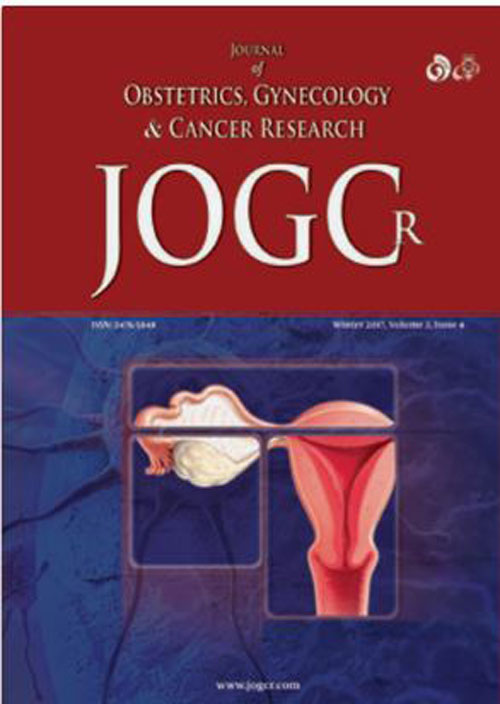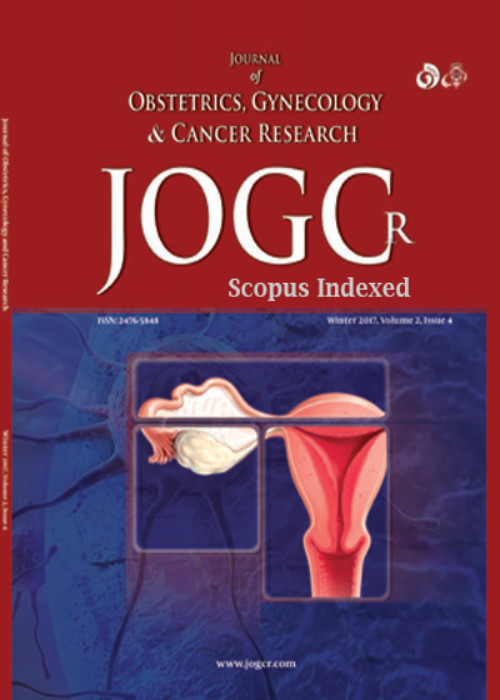فهرست مطالب

Journal of Obstetrics, Gynecology and Cancer Research
Volume:2 Issue: 3, Summer 2017
- تاریخ انتشار: 1396/05/18
- تعداد عناوین: 8
-
-
Page 1
Lymphedema is an unusual and specific type of peripheral edema resulting from obstruction or disruption of lymphatic system. The present review was conducted on PubMed, UpToDate, and ClinicalKey databases before 2016. The keywords included lymphedema or leg edema AND advanced malignancy. The primary review revealed 104 full text publications, of which 24 relevant articles were selected and another 17 relevant articles from the reference list of the selected articles were added, as well. Practical points in diagnosis and treatment of lymphedema in gynecologic malignancies are presented in the below subtitles: -basic descriptions, classifications, and epidemiology; -clinical presentation and diagnostic tests; -differential diagnosis; -non-surgical management; -surgical management.
Keywords: Lymphedema, Neoplasm, Radiotherapy, Lymph Node Excision, Iran -
Page 2Introduction
Myoma is the most common benign tumor of the female genital tract. The incidence of myoma increases with age. It mostly presents in the fifth decade of life. Since myoma is often asymptomatic and incidentally diagnosed, the true prevalence is unknown. This tumor may also become symptomatic and affect women’s quality of life. This study was performed to report a rare case of vaginal myomectomy in post-partum severe hemorrhage caused by a submucosal myoma.
Case ReportA 39-year-old G2P1 woman with previous cesarean section and decreased fetal movement at 38th week of gestation was hospitalized. In sonography and biophysical profile, due to fetal compromised, pregnancy was terminated. After delivery of fetus, a submucosal myoma (12 × 12 cm) was protruded through cervical canal. Massive hemorrhage occurred and then vaginal myomectomy was done and the bed of myoma was packed with two long gauzes that removed after one day.
ConclusionsVaginal myomectomy after natural vaginal delivery or possibly during cesarean section is a safe and reliable method to remove submucosal myomas especially large myomas and decrease the risk of complications and costs of re-surgery. Due to the increased risk of hemorrhage, it is better to conduct this surgery in third-level referral hospitals.
Keywords: Myomectomy, Post-Partum Hemorrhage, Submucosal Myoma -
Page 3Introduction
HELLP syndrome is a life-threatening complication of preeclampsia. We report a young pregnant woman with HELLP syndrome who was diagnosed, managed, and delivered in a timely manner.
Case PresentationA 23-year-old second gravida twin pregnant woman was referred to our clinic due to high blood pressure. After delivery, she experienced a hemolytic condition with elevated liver enzymes and thrombocytopenia, defined as HELLP syndrome. After confirmation of HELLP syndrome by laboratory tests, the patient underwent hemodialysis and plasmapheresis. 10 days later, she was discharged under good general condition.
ConclusionsWomen with a history of HELLP syndrome are considered to have an increased risk of death. Therefore, this lifethreatening condition should be closely monitored and treated in a timely manner.
Keywords: HELLP Syndrome, Pregnancy, Preeclampsia -
Page 4Introduction
Utero-cutaneous fistula is a rare condition following uterine surgeries especially cesarean section. This kind of fistula has various etiologies including drain use, iatrogenic trauma, endometriosis, multiple abdominal surgeries, incomplete closure of uterine wound during cesarean delivery, inflammatory processes related to intra-abdominal sepsis or infectious, and dislocation of intrauterine devices.
Case PresentationThis report deals with two unusual cases of utero-cutaneous fistula. The patients referred with discharge from abdominal wall. The first one had vesico-cutaneous fistula simultaneously. Both of them had a second cesarean section. After four months of cesarean section, in fistulography report of the first case, it was found irregular fistula tract associated with vagina following cannulation and contrast injection. In the second case, ultrasonography revealed the attachment of uterus to abdominal wall as well as accumulation and communication of the small amounts of fluid from uterine cavity to abdomen wall. After confirming the diagnosis, the repairing surgery was successfully planned.
ConclusionsCesarean has some rare morbidity such as uterocutaneous fistula that needs awareness of physician and patient. The early diagnosis and repairing of this abnormality is essential.
Keywords: Utero-Cutaneous Fistula, Cesarean Section, Perinatal Morbidity, Side Effects -
Page 5Introduction
Giant fibroadenomas are an uncommon breast tumor accounting for 0.5% to 2% of all cases of fibroadenomas. Diagnosis is difficult due to the rarity of giant fibroadenomas and the resemblance of its clinical and imaging features with other breast neoplasms, especially phyllodes tumor.
Case PresentationThe authors report a rare case of giant fibroadenoma in a 14-year-old South Sudanese female, which was suspected clinically, ultrasonography, and by fine needle aspiration cytology and confirmed by histopathology after total mass excision.
ConclusionsFibroadenomas presenting a very large diameter could bemistaken withmalignancy and other benign breast lesions. Fine needle aspiration biopsy and core needle biopsy appears fundamental to evaluate their benign nature. Conservative surgery using sub-mammary incision is the gold standard of treatment with good cosmesis.
Keywords: Breast Mass, Giant Fibroadenoma, Conservative Surgery -
Page 6Introduction
The incidence of vulvar cancer is nearly 5% of all gynecologic malignancies and almost 95% of vulvar cancers are squamous cell carcinoma (SCC). Recurrence is possible in 4 ways: local, regional, pelvic, and distant. In a cohort of 391 patients with vulvar SCC, distant metastasis was reported 5% .The common sites of distant metastasis are pelvic nodes, lung, and liver. Both skin and bone metastasis are rare in vulvar SCC.
Case PresentationThe current report presented a 58-year-old female with the diagnosis of vulvar SCC. She was the 11th cutaneous metastasis, 13th bone metastasis, and the 1st case with simultaneous bone and skin metastasis reported in the last 60 years.
ConclusionsIt is necessary to consider any lesion on the vulve, especially inmenopause females, and it should be the low threshold for biopsy to avoid delay in detection. After completion of selective treatment, the exact follow-up should be considered to discover metastases.
Keywords: Squamous Cell Carcinoma, Vulvar Cancer, Cutaneous Metastasis -
Page 7Introduction
The aim of this study was to describe clinical findings of prolapse of fallopian tube to vaginal vault following abdominal hysterectomy for multiple leiomyomas of uterine and to correlate it with other features.
Case PresentationA patient with history of leiomyomas and abnormal uterine bleeding was admitted with abdominal pain and scheduled for abdominal hysterectomy. Intra operative inspection showed multiple leiomyomas of uterine. One year after operation of total abdominal hysterectomy, the patient presented with abdominal pain, dyspareunia, and purulent vaginal discharge and therefore, referred to our center for further evaluation. In the vaginal examination, a protruding red mass with fibrotic fimberia was observed. The right fallopian tube (FT) with its fimbria prolapsed to vaginal vault as a granulation tissue was removed from vaginal cuff and sent to pathology. The pathologist reported fallopian tube tissue. Post-operative course was uneventful and the patient was discharged on 2nd day of post hysterectomy with good general condition. Six-month follow-up showed abolished purulent discharge. The site of resected vaginal cuff was intact in vaginal examination.
ConclusionsIntra vaginal prolapse of the fallopian tube is a rare sequel of hysterectomy. Clinicians should be aware of this disregarded sequel when dealing with post-hysterectomy vaginal discharge.
Keywords: Gynecology Surgery, Prolapse of Fallopian Tube, Vaginal Discharge -
Page 8Introduction
Synovial sarcoma of the ovary is a very rare tumor reported only once in the past. It is the second softest tissue mass after rhabdomyosarcoma in adults but its usual site is extremities not ovary.
Case PresentationHere we describe a 53-year-old woman with primary synovial sarcoma of the ovary with insufficient treatment and lung metastasis of the tumor.
ConclusionsBecause of harmlessness symptoms, it is usually missed and correct treatment is delayed. When facing this type of tumor, referring to well-equipped centers with experienced surgeons in this field is recommended for sufficient treatment and best results.
Keywords: Synovial Sarcoma, Ovarian Tumor, Lung Metastasis


